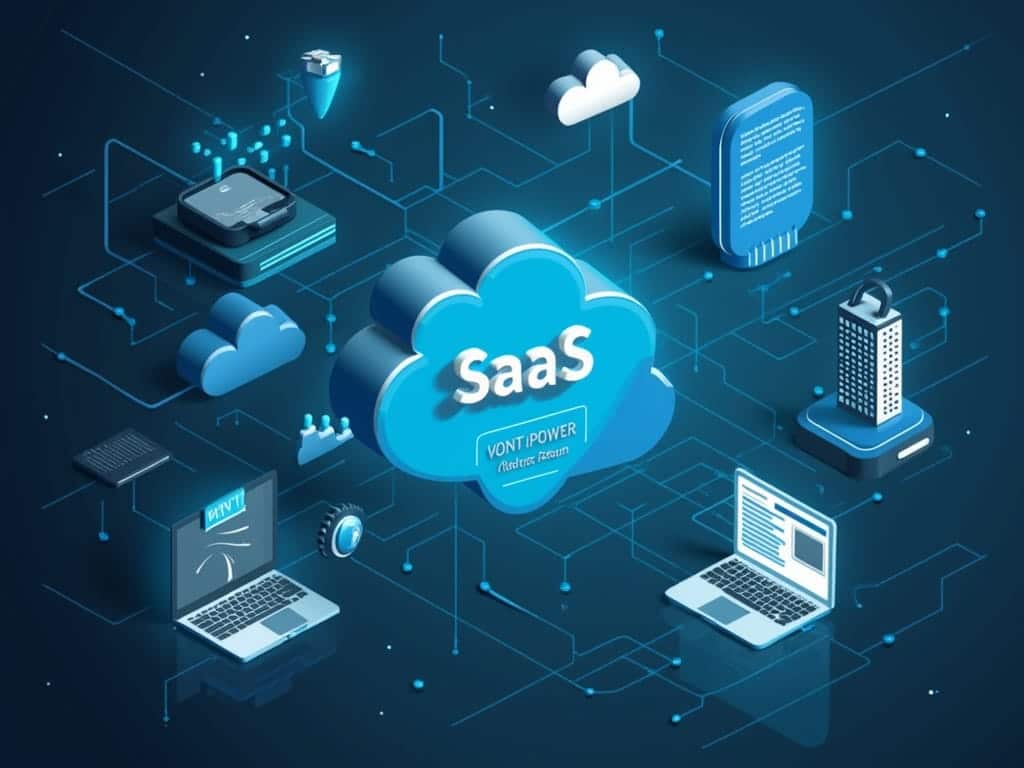I define Software as a Service (SaaS) as a cloud-based system that lets users access applications through their web browsers instead of installing software locally. This subscription model has changed how companies buy and use software, making it easier to scale operations, receive automatic updates, and cut initial expenses while avoiding the hassle of managing complex infrastructure.
Key Takeaways:
- SaaS platforms operate on multi-tenant architecture, enabling thousands of customers to use identical applications while keeping their data separate and secure
- Moving to a subscription model converts large upfront payments into predictable monthly costs, simplifying budget planning
- Businesses can adapt their resource usage instantly without buying new equipment
- Industry leaders Salesforce, Microsoft, and Adobe set quality benchmarks through their successful SaaS products
- Modern security features like encryption, multi-factor authentication, and automatic backups ensure data protection
What Makes SaaS Different from Traditional Software?
Core Differences in Architecture and Access
SaaS stands apart from traditional software through its cloud-based delivery model. Instead of installing programs on your computer, you access SaaS applications directly through a web browser. This eliminates the need for complex local installations or hardware requirements.
The fundamental differences between SaaS and traditional software include:
- Subscription-based payment instead of one-time licensing fees
- Instant access from any device with an internet connection
- Automatic updates without manual installations
- Multi-tenant architecture where multiple users share the same application instance
- No need for local storage or processing power
The multi-tenant architecture sets SaaS apart by allowing thousands of users to access the same application while maintaining strict data separation. Popular examples like Google Workspace showcase this capability, serving millions of users simultaneously while keeping each organization’s data secure and separate.
This shift from owned software to subscription-based access transforms how businesses manage their IT resources. With SaaS, I’ve seen companies reduce their upfront costs and gain flexibility in scaling their software usage up or down. Microsoft 365 exemplifies this model, letting businesses adjust their user counts monthly while providing automatic feature updates to all subscribers.

The Business Case for SaaS
Financial and Operational Benefits
SaaS delivers clear financial advantages through its subscription-based model. Instead of massive initial investments, businesses pay regular fees that match their actual usage. This shift from capital expenditure to operational costs makes budgeting more predictable.
The financial impact extends beyond initial savings. I’ve identified several key benefits that make SaaS an attractive option:
- Lower infrastructure costs with no need for on-site servers or hardware maintenance
- Reduced IT staff requirements as updates and security are handled by providers
- Flexible scaling options to adjust resources based on business needs
- Built-in disaster recovery and backup systems
- Automatic software updates without additional fees
Scalability remains a major draw for businesses adopting SaaS solutions. Companies can quickly add or remove users, features, or storage capacity without investing in new infrastructure. This flexibility proves valuable for seasonal businesses or those experiencing rapid growth.
The market data backs up these advantages. According to Gartner, global SaaS spending reached $146 billion in 2021, showing a 19% increase from the previous year. Small businesses particularly benefit, with IDC reporting that 78% of small enterprises now use SaaS solutions to compete more effectively with larger organizations.
By eliminating hardware costs and maintenance responsibilities, organizations can focus resources on core business activities while maintaining access to enterprise-grade software solutions.

Leading SaaS Providers and Market Overview
Key Market Leaders and Business Models
The SaaS market features several dominant companies that shape industry standards. Salesforce leads in customer relationship management, while Microsoft’s 365 suite dominates productivity tools. Adobe has transformed creative software delivery through Creative Cloud, and Oracle powers enterprise resource planning solutions.
Here’s how top providers influence the market:
- Salesforce and Zendesk drive innovation in customer service platforms
- Microsoft Azure and AWS provide essential infrastructure for countless SaaS applications
- Adobe Creative Cloud sets subscription pricing standards
- Oracle focuses on large-scale enterprise solutions
The B2B sector shows strong adoption rates, with companies embracing subscription-based software. I’ve noticed freemium models gaining popularity, where providers offer basic features at no cost while charging for advanced capabilities. This approach helps businesses test solutions before committing to paid versions.
Common SaaS Applications in Business
Essential Business Software Categories
Modern businesses rely on SaaS applications to power their daily operations. Customer Relationship Management (CRM) platforms like Salesforce help teams track customer interactions and sales pipelines in real-time. Enterprise Resource Planning (ERP) systems from providers such as SAP and Oracle combine finance, supply chain, and operations into one central hub.
I’ve identified key SaaS tools that drive workplace efficiency. Here are the main categories and popular options:
- Collaboration Tools: Slack and Microsoft Teams enable instant messaging, file sharing, and virtual meetings
- HR Management: Workday and BambooHR streamline employee data, payroll, and recruitment
- Business Analytics: Tableau and Power BI transform raw data into actionable insights
- Project Management: Asana and Trello organize tasks and track project progress
- Document Management: Google Workspace and Microsoft 365 support file creation and sharing
These tools work together to create a connected digital workplace. For example, a sales team can use Salesforce to track leads, Slack to discuss opportunities, and Power BI to analyze performance metrics – all through cloud-based interfaces. By selecting the right mix of these applications, companies can build a customized tech stack that matches their specific needs without heavy IT infrastructure investments.
Security and Technical Considerations
Data Protection and System Architecture
SaaS platforms must maintain strong security measures to protect sensitive customer data. Modern SaaS applications use advanced encryption protocols during data transmission and storage. Multi-factor authentication adds an essential security layer, requiring users to verify their identity through multiple methods before accessing the system.
Here are the key technical components that make SaaS applications secure and efficient:
- End-to-end encryption for all data transfers and storage
- Multi-factor authentication options including biometrics and time-based codes
- Regular security audits and compliance monitoring
- Automated backup systems with geographic redundancy
- API endpoints with secure authentication tokens
The infrastructure supporting SaaS applications typically relies on IaaS (Infrastructure as a Service) or PaaS (Platform as a Service) providers. IaaS offers complete control over the computing environment, while PaaS provides a ready-made platform for faster deployment. The choice between these options depends on specific business needs and technical requirements.
API integration capabilities allow SaaS applications to connect with other software systems seamlessly. This interconnectivity enables data sharing, workflow automation, and enhanced functionality across different platforms. Modern APIs include rate limiting, versioning, and comprehensive documentation to support developer implementation.
Implementation and Integration Challenges
System Integration Barriers
Connecting SaaS applications with existing software can create technical hurdles. I recommend starting with an assessment of your current systems’ compatibility before selecting a SaaS provider. Legacy systems often need additional middleware or APIs to communicate effectively with new SaaS platforms, adding time and cost to implementation.
Data and Customization Constraints
SaaS solutions have built-in limits on customization options. Here are key considerations before implementing a SaaS solution:
- Data sovereignty can be restricted by regional regulations and storage locations
- Standard features might not match specific business processes
- Limited access to source code reduces modification possibilities
- Service Level Agreements (SLAs) may not guarantee desired uptime
- Migration of existing data requires careful planning and verification
While SaaS platforms offer quick deployment, these constraints can impact your operations. I suggest creating a detailed requirements document that outlines your must-have customizations and data control needs. Pay special attention to SLAs – they’re your guarantee of service quality and availability. Clear communication with vendors about integration needs and customization limits helps prevent implementation delays and unexpected costs.
Some businesses opt for hybrid solutions, keeping critical systems in-house while moving less sensitive operations to SaaS platforms. This approach balances the benefits of cloud services with the control of traditional software.
Sources:
DigitalOcean – What is SaaS
Built In – SaaS
Fortune Business Insights – Software as a Service Market
Related Posts

Addressing Compliance Challenges with Managed Services
In today’s business landscape, compliance with regulatory standards is not just a recommendation—it’s a necessity. Businesses across industries face a myriad of compliance regulations, each with its own set of requirements and implications. From protecting customer data to ensuring financial transparency, compliance regulations like GDPR, HIPAA, PCI DSS, NIST, and ISO27001

Top 5 Office 365 Apps You’re Overlooking That Could Save You Money
Office 365’s advanced applications offer viable alternatives to expensive third-party software, helping organizations reduce annual subscription costs by thousands of dollars. I’ve found that native

Microsoft Exchange Server End of Life: Upgrade or Migrate?
Here’s my response with the text formatted in correct HTML: Microsoft’s deadline for Exchange Server 2016 and 2019 support ends October 14, 2025, pushing organizations
